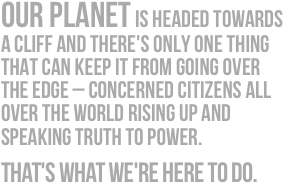by Samuli Sinisalo
In the UNFCCC, and especially in Durban, there are two major forces in play. The obvious surface is of course that of saving the planet and the climate system from disastrous anthropogenic interference. That is why these meetings are organized in the first place, and it is even inscribed in article two of the convention.
The other force in play is how is this to be done? Who should cut emissions and how much, how are countries to adapt to the climate change? This is where it gets more complicated, confusing and where the blame-game starts.
The developed countries have enjoyed unlimited access to the atmospheric space for well over a century now. Environmental concerns were hardly an issue as the global north climbed the ladder of development and brought their economies to the current standards. For the time being the amount of economic activity is closely linked to the GHG-emissions, especially if countries are to pursue the most cost-effective development strategies.
For many developing countries, the negotiations are not just questions of tackling the climate change, but also about ensuring the right to develope their economies. This has been recognized in the convention by the concept of common but differentiated responsibilities and respective capabilities (CBDR and RC). Up to now, the Annex 1 countries have had the responsibility to cut their emissions and provide financial assistance to the developing countries to deviate from their business-as-usual developmental baseline, and to adapt to climate change.
Durban was a failure because it failed to provide the next legally binding emissions reduction targets. The world has to be satisfied with the EU and a few other countries turning their domestic climate legislation into internationally recognizable form – with very low ambition. Obviously not enough.
The other promise from Durban is to negotiate a new global legal instrument, which has legal force on all countries. This is very concerning for many developing countries, and the most vocal about it in Durban was India. They reminded the world that India a major emitter due only to its size, the emissions historically, as well as per capita, are very low. They do want to preserve their right to lift people out of poverty and develope. The ladder cannot be kicked away, even as the threat of climate change becomes more dire by the day.
As time drags on, and climate change becomes more pressing, the most vulnerable countries have to accept any deal, or there will be no future for the planet. Hopefully they don’t have to sell out their own future by committing to reducing their climate footprint.
Personally I am still hopeful that the Durban Mandate might lead to something, but there is a great chance it is too little and too late. As well as it might be the wrong thing all together. It is a shame they countries failed to deliver a new outcome based on the Bali Action Plan. In the BAP, the CBDR and equity were safeguarded. But this was not enough, especially for the United States.
I put the disaster in brackets for the time being, as I hope a reason to delete it from the text would arise when negotiations get on the way again, but it might be too much to ask.


